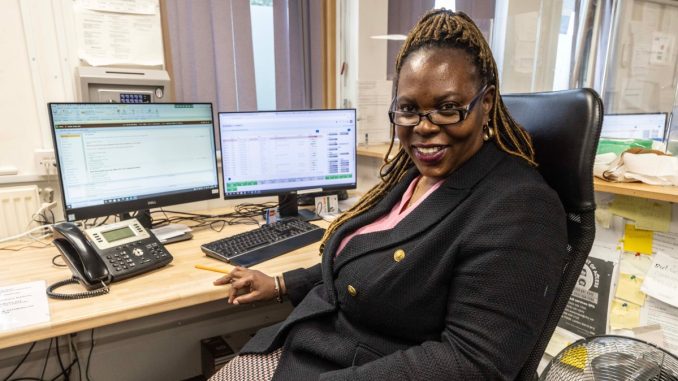
On a normal Monday morning, Julie Schultzers and her team of GP receptionists receive 500 calls. Previously, it was impossible to answer all calls during this ‘8 a.m.’ period, forcing some patients to hang up or go to the emergency room.
Now staff at Wide Way Medical Center in South London have come up with an innovative solution that ensures every call is answered – by deploying ambulance call handlers.
Under a pilot scheme, 80 per cent of patients who call a GP surgery for a same-day appointment will be referred to a separate hub of 20 call handlers employed by the London Ambulance Service, based 15 miles away in Barking, east London.

David Chung has been registered with the practice since 1978 and remembers the moments when you just showed up for an appointment
TIMES PHOTOGRAPHER RICHARD POHLE
This new, The dedicated team of the “GP Support Service” notes symptoms and, if necessary, books patients for an appointment at the practice, or can refer them to a pharmacy or send an ambulance. The system, which operates between 8am and 1pm every weekday, has more than doubled the GP practice’s capacity to answer calls.
“Previously, some patients had to wait half an hour before they could get through,” says Schultzers, the head receptionist. “It was very stressful and busy, patients became upset. Now the average time to answer the phone is less than five minutes. It has made a huge difference.”
The program was launched in East Merton, which serves a population of 50,000, in October last year and is now being scaled up to other NHS practices.
Not only does it ease the pressure on GPs, but it has also significantly reduced demand on local hospitals, resulting in hundreds of fewer patients going to A&E out of desperation to be seen. Modeling shows that the system could save 725,000 A&E visits a year if it were rolled out across London, saving the NHS millions of pounds.

A receptionist talks to a patient at the clinic, which has been running a pilot since October last year
TIMES PHOTOGRAPHER RICHARD POHLE
Dr. Johra Alam, clinical director for emergency care at the London Ambulance Service, said it made perfect sense to integrate the ambulance service’s existing ‘telephony infrastructure’ with that of struggling GP practices, where problems reaching the phone are the biggest frustration goods. confronted with patients.
“Answering the phone quickly is what we do at the ambulance service. It is our field,” she says. “Scaling up this model would have a huge impact on emergency care. If patients don’t currently have access to their GP, they will go elsewhere in the system – the pressure spills over into A&E.”
Access to general practitioners will be an important theme in the election campaign. The latest official data shows that one in three people found it ‘difficult or very difficult’ to contact their GP, while one in 20 were told to call back on another day. Polls show that one in five patients attended the emergency department because they could not get an appointment with their GP.
Dr. Sayanthan Ganesaratnam, GP at Wide Way Medical Centre, said the success of the trial highlights the importance of ending a culture within the NHS where different services “work in silos”. He said: “GP practices simply cannot provide enough telephone lines or enough space for receptionists to deal with the high volume of calls we receive. But by pooling resources with the London Ambulance Service, it means our patients can always speak to someone on the phone – and get the right care, at the right time, in the right place.”

Michelle Le Blanc, one of the receptionists, tries to answer as many calls as possible
TIMES PHOTOGRAPHER RICHARD POHLE
This collaboration between general practitioners and emergency services – the first of its kind – has already proven to be life-saving. In one case, an 83-year-old man with a diabetes emergency called the GP practice during a busy period and was transferred to the ambulance call centre. Staff identified “red flags” and an emergency ambulance was immediately dispatched, whereas previously he may have been on hold for an hour or his call may not have been answered. Patient satisfaction has improved significantly.
Those who would benefit include David Chung, 79, who has been a patient at the GP surgery since 1978 and can remember the days when you simply ‘turned up outside the surgery’ to make an appointment. “Some GPs now ensure that everyone books online. But for members of my generation, technology can be difficult and it is important that we know that when we call, the phone will always be answered,” he said.
Matthew Taylor, CEO of the NHS Confederation, said: “This partnership between two of our members, East Merton Primary Care Network, and the London Ambulance Service, perfectly demonstrates how different parts of the NHS can come together and create something new, ambitious . and effective.
“The data shows how this trial will save all parts of the system money at a time when every cent counts, and reduce the number of emergency rooms so that only those who really need emergency care can access it as quickly as possible. It also ensures that the 30,000 patients in the two GP practices in the PCN who use this service receive the right care they need, at the right time and in the right place, at the same time.”
Leave a Reply